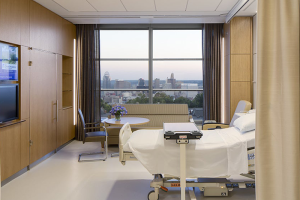Finding inspiration from the front row
Over the course of our careers, many of us reach a point where we need to reignite and refuel our professional passion. Where and how we find the inspiration to recreate a renewed sense of purpose can be intentional or completely circumstantial. It might be the result of a deep and thoughtful search, a serendipitous encounter or conversation, a compelling story or idea, a moment of unexpected clarity or a life-altering — for better or worse — personal experience.
After more than 35 years of talking about, advocating for and supporting health care environments that contribute to the best possible health outcomes, I got a front-row seat — or really, a front-row bed — to experience firsthand the state of patient care, the impact of our health care design efforts and how much progress we’ve made over the last three and a half decades.
Just after New Year’s, I bent down to pick up something that, let’s be honest, was probably too heavy for me. But like a lot of you out there of a certain age, in my mind I’m still 25 and invincible. What started out feeling like a minor pulled muscle escalated into a herniated disc — at the absolute worst possible spot in my spine — and left me completely incapacitated in a heap of excruciating pain.
Cue the 911 call and ambulance ride to the emergency room. I was quickly admitted, hoping for an insta-fix, but instead ended up on a three-week roller coaster of physical and psychological ups and downs in search of a diagnosis, treatment and relief. The vulnerability that comes with not knowing when or how the pain will end is something I won’t soon forget.
The good news? I spent that time in a generally comfortable and attractive single-patient room — four of them, actually — that was thoughtfully designed with a private bathroom; plenty of storage; clear zones for patients, families and staff; and even space for visiting guests.
One of the best surprises? When the door shut, the room was quiet. Not just hospital quiet, but calm and rest-conducive quiet. One of my rooms overlooked a lovely rehab garden patio.
I can now officially confirm that Roger Ulrich was spot-on in his seminal 1984 study, “View through a window may influence recovery from surgery.” Having a view of nature makes a difference.
On the hard days, that view gave me something to focus on besides the pain, brought the outside in and enabled me to imagine the comforting feel of sun on my skin, the breeze on my face and the scent of blossoming flowers. It reminded me that even subtle design choices can profoundly shape the human experience.
Each room I stayed in checked the big boxes of best practices The Center for Health Design was advocating for almost 20 years ago when this hospital was designed. And yet ... as much as it worked, there were places where it simply missed the mark.
Here’s what I learned:
First, yes, getting the environment right is critical to the patient experience and achieving health outcomes. But when you’re in serious pain, any design miss — no matter how seemingly small — magnifies 10-fold the frustration and dissatisfaction you might be feeling as a patient.
And distance matters. I couldn’t sit, walk or stand for more than a few minutes without resurging, searing pain, so getting to the bathroom became a full-on exercise in strategic planning. Anything standing in my path was violently shoved aside like so many defensive linemen blocking my forward progress.
Furniture matters, too. For friends and family who stayed by my side for 16-hour days, having comfortable, flexible seating wasn’t just a nice-to-have — it was essential. A lot of the furniture looked good, but after a short time sitting on it, it became painfully clear that it wasn’t built for lasting comfort. Furniture testing should require designers to sit in their creations for at least four hours straight.
As much as the health care environment needed to support me and my visitors, it was the hospital staff that truly made or broke my experience. We’ve spent a lot of time post-COVID-19 talking about creating spaces for staff to decompress, and we absolutely should. But we also need to think about creating environments where experienced nurses can mentor new ones — because, trust me, that dynamic matters.
I was cared for by some incredible, skilled and compassionate people. But I also encountered far more than I expected who were inexperienced, stressed or just plain exhausted. And when that happens, mistakes can happen.
Design matters. But it’s not enough on its own. We need to design health care environments that not only support healing but also lift up the people who are delivering patient care day after day. Beautiful patient rooms can’t solve staffing shortages or burnout. Private bathrooms and garden views can’t replace mentorship or emotional resilience. If we really want better health outcomes, we must treat the care team’s well-being with the same urgency as the patient’s.
I thought I knew that before. Now, after this eye-opening experience, I know it in my bones.
Sometimes it takes being the patient to see just how much our work matters.
About this column
“From The Center” is by the leadership of The Center for Health Design and appears in alternating issues of Health Facilities Management magazine.




